Case Study: Southwest Airlines' Business Strategy Analysis
VerifiedAdded on 2020/05/16
|9
|1677
|147
Case Study
AI Summary
This case study provides a comprehensive analysis of Southwest Airlines, examining its operations, business strategies, and market position. The study utilizes a SWOT analysis to identify the airline's strengths, such as its low-cost model, excellent management, and efficient employee selection, while also pointing out weaknesses like lack of innovation and dependence on a single aircraft type. Opportunities like the AirTran acquisition and hub-and-spoke network are discussed, along with threats like high operating costs and geopolitical factors. The case study also identifies key concepts such as yield management, hub and spoke networks, and leading with integrity, illustrating how Southwest has navigated the competitive U.S. airline industry. The conclusion highlights the factors that could impact Southwest's future growth and suggests strategies for maintaining its competitive edge. References are provided for further study.
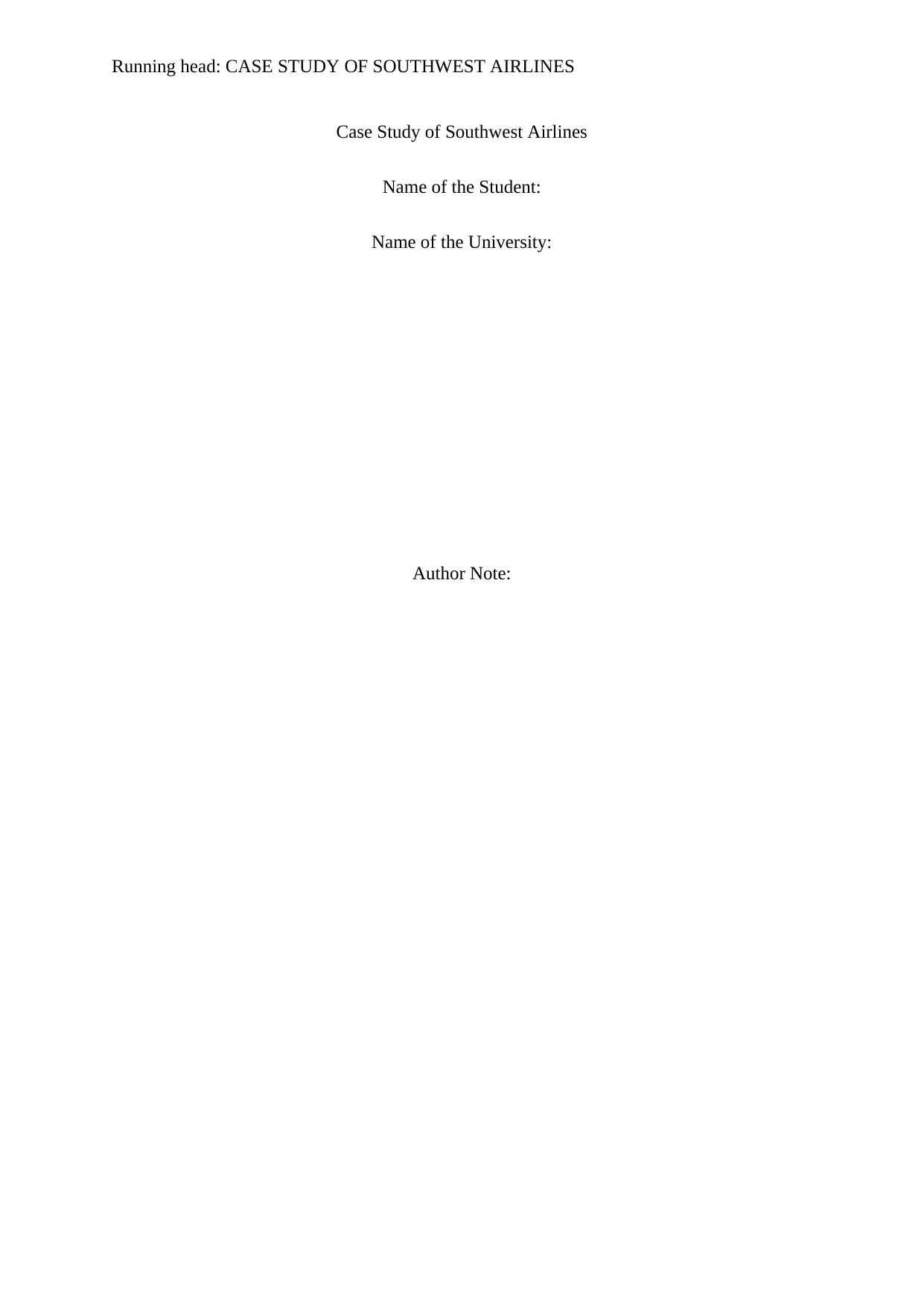
Running head: CASE STUDY OF SOUTHWEST AIRLINES
Case Study of Southwest Airlines
Name of the Student:
Name of the University:
Author Note:
Case Study of Southwest Airlines
Name of the Student:
Name of the University:
Author Note:
Paraphrase This Document
Need a fresh take? Get an instant paraphrase of this document with our AI Paraphraser
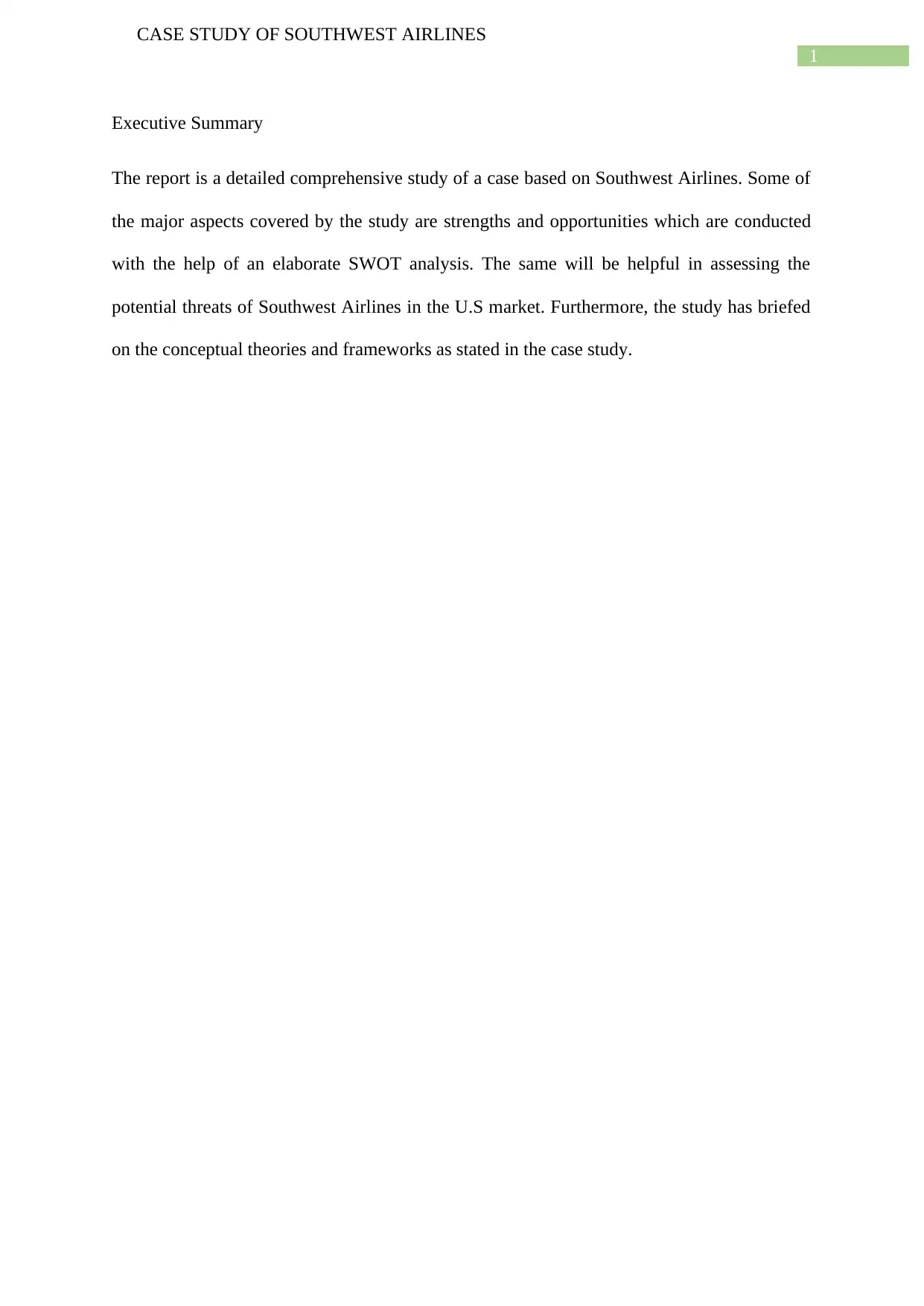
1
CASE STUDY OF SOUTHWEST AIRLINES
Executive Summary
The report is a detailed comprehensive study of a case based on Southwest Airlines. Some of
the major aspects covered by the study are strengths and opportunities which are conducted
with the help of an elaborate SWOT analysis. The same will be helpful in assessing the
potential threats of Southwest Airlines in the U.S market. Furthermore, the study has briefed
on the conceptual theories and frameworks as stated in the case study.
CASE STUDY OF SOUTHWEST AIRLINES
Executive Summary
The report is a detailed comprehensive study of a case based on Southwest Airlines. Some of
the major aspects covered by the study are strengths and opportunities which are conducted
with the help of an elaborate SWOT analysis. The same will be helpful in assessing the
potential threats of Southwest Airlines in the U.S market. Furthermore, the study has briefed
on the conceptual theories and frameworks as stated in the case study.
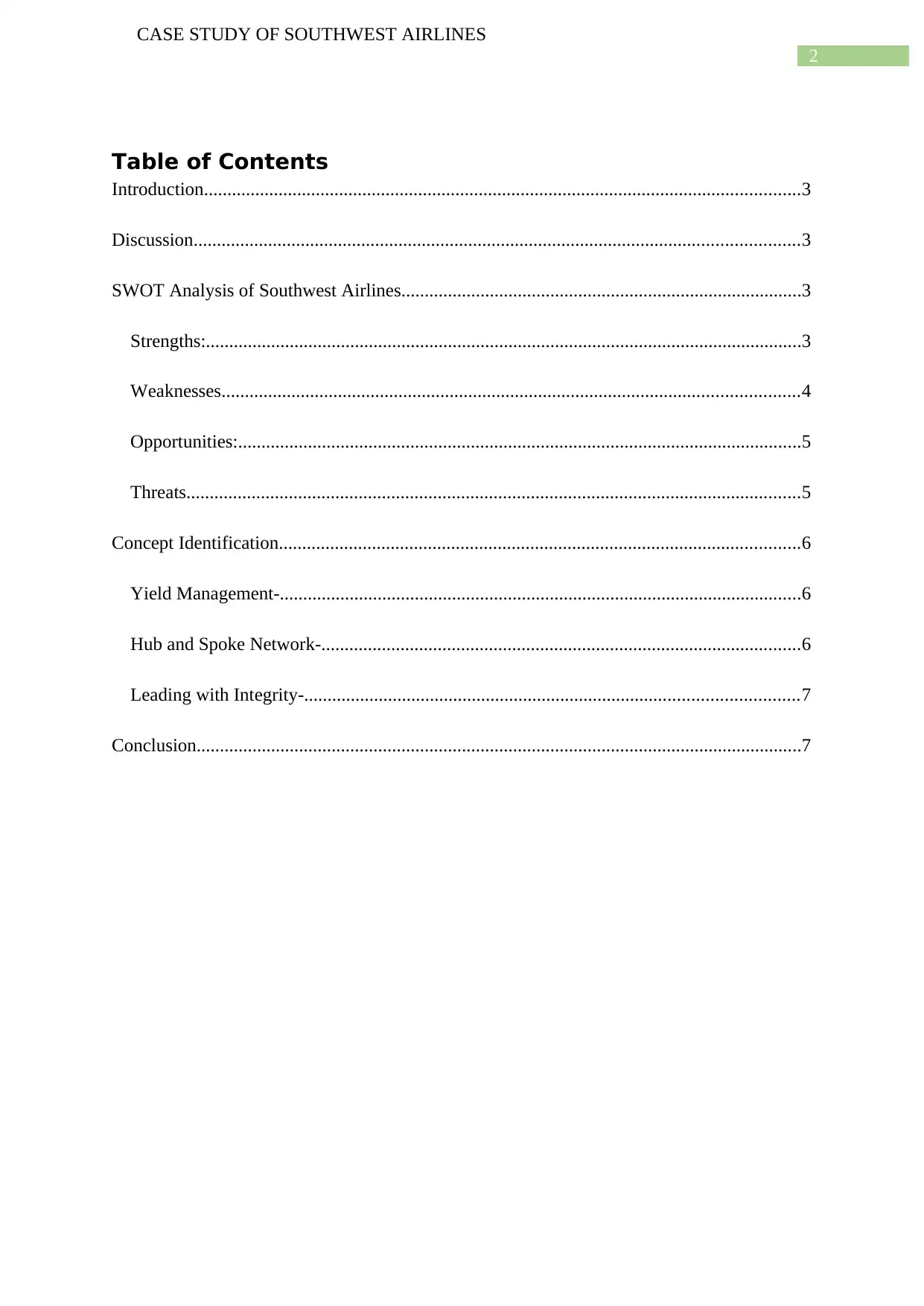
2
CASE STUDY OF SOUTHWEST AIRLINES
Table of Contents
Introduction................................................................................................................................3
Discussion..................................................................................................................................3
SWOT Analysis of Southwest Airlines......................................................................................3
Strengths:................................................................................................................................3
Weaknesses............................................................................................................................4
Opportunities:.........................................................................................................................5
Threats....................................................................................................................................5
Concept Identification................................................................................................................6
Yield Management-................................................................................................................6
Hub and Spoke Network-.......................................................................................................6
Leading with Integrity-..........................................................................................................7
Conclusion..................................................................................................................................7
CASE STUDY OF SOUTHWEST AIRLINES
Table of Contents
Introduction................................................................................................................................3
Discussion..................................................................................................................................3
SWOT Analysis of Southwest Airlines......................................................................................3
Strengths:................................................................................................................................3
Weaknesses............................................................................................................................4
Opportunities:.........................................................................................................................5
Threats....................................................................................................................................5
Concept Identification................................................................................................................6
Yield Management-................................................................................................................6
Hub and Spoke Network-.......................................................................................................6
Leading with Integrity-..........................................................................................................7
Conclusion..................................................................................................................................7
⊘ This is a preview!⊘
Do you want full access?
Subscribe today to unlock all pages.

Trusted by 1+ million students worldwide
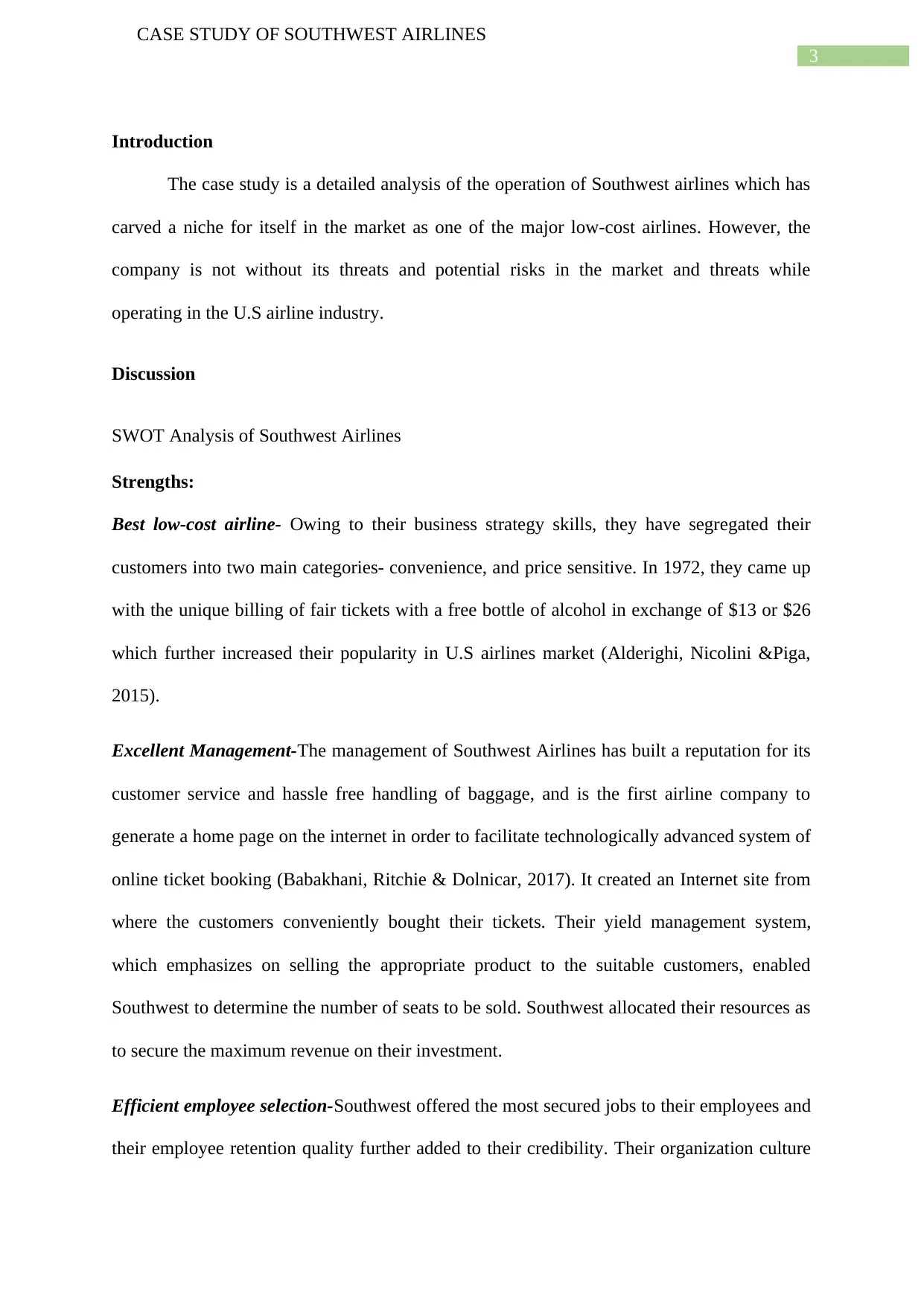
3
CASE STUDY OF SOUTHWEST AIRLINES
Introduction
The case study is a detailed analysis of the operation of Southwest airlines which has
carved a niche for itself in the market as one of the major low-cost airlines. However, the
company is not without its threats and potential risks in the market and threats while
operating in the U.S airline industry.
Discussion
SWOT Analysis of Southwest Airlines
Strengths:
Best low-cost airline- Owing to their business strategy skills, they have segregated their
customers into two main categories- convenience, and price sensitive. In 1972, they came up
with the unique billing of fair tickets with a free bottle of alcohol in exchange of $13 or $26
which further increased their popularity in U.S airlines market (Alderighi, Nicolini &Piga,
2015).
Excellent Management-The management of Southwest Airlines has built a reputation for its
customer service and hassle free handling of baggage, and is the first airline company to
generate a home page on the internet in order to facilitate technologically advanced system of
online ticket booking (Babakhani, Ritchie & Dolnicar, 2017). It created an Internet site from
where the customers conveniently bought their tickets. Their yield management system,
which emphasizes on selling the appropriate product to the suitable customers, enabled
Southwest to determine the number of seats to be sold. Southwest allocated their resources as
to secure the maximum revenue on their investment.
Efficient employee selection-Southwest offered the most secured jobs to their employees and
their employee retention quality further added to their credibility. Their organization culture
CASE STUDY OF SOUTHWEST AIRLINES
Introduction
The case study is a detailed analysis of the operation of Southwest airlines which has
carved a niche for itself in the market as one of the major low-cost airlines. However, the
company is not without its threats and potential risks in the market and threats while
operating in the U.S airline industry.
Discussion
SWOT Analysis of Southwest Airlines
Strengths:
Best low-cost airline- Owing to their business strategy skills, they have segregated their
customers into two main categories- convenience, and price sensitive. In 1972, they came up
with the unique billing of fair tickets with a free bottle of alcohol in exchange of $13 or $26
which further increased their popularity in U.S airlines market (Alderighi, Nicolini &Piga,
2015).
Excellent Management-The management of Southwest Airlines has built a reputation for its
customer service and hassle free handling of baggage, and is the first airline company to
generate a home page on the internet in order to facilitate technologically advanced system of
online ticket booking (Babakhani, Ritchie & Dolnicar, 2017). It created an Internet site from
where the customers conveniently bought their tickets. Their yield management system,
which emphasizes on selling the appropriate product to the suitable customers, enabled
Southwest to determine the number of seats to be sold. Southwest allocated their resources as
to secure the maximum revenue on their investment.
Efficient employee selection-Southwest offered the most secured jobs to their employees and
their employee retention quality further added to their credibility. Their organization culture
Paraphrase This Document
Need a fresh take? Get an instant paraphrase of this document with our AI Paraphraser
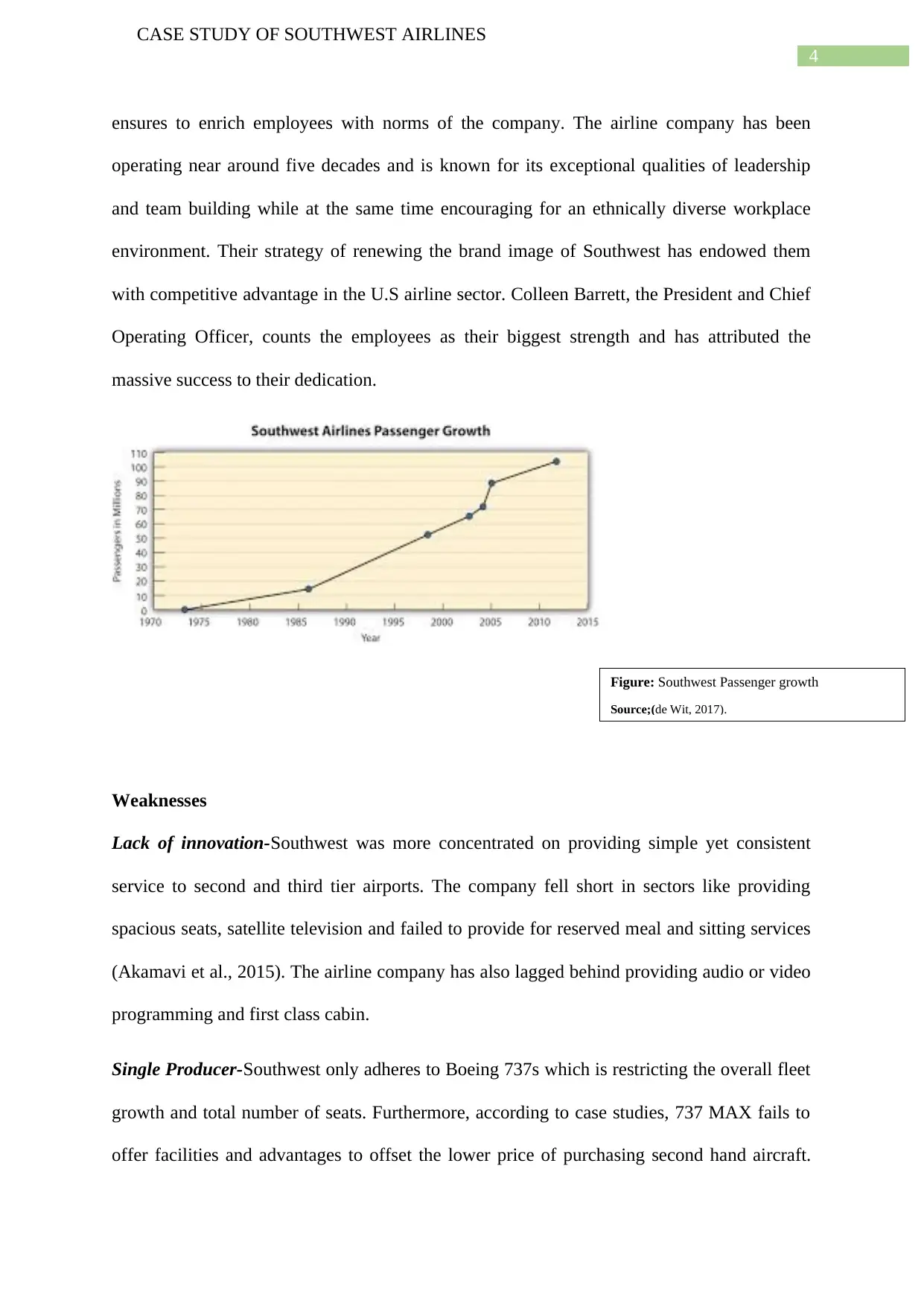
4
CASE STUDY OF SOUTHWEST AIRLINES
ensures to enrich employees with norms of the company. The airline company has been
operating near around five decades and is known for its exceptional qualities of leadership
and team building while at the same time encouraging for an ethnically diverse workplace
environment. Their strategy of renewing the brand image of Southwest has endowed them
with competitive advantage in the U.S airline sector. Colleen Barrett, the President and Chief
Operating Officer, counts the employees as their biggest strength and has attributed the
massive success to their dedication.
Weaknesses
Lack of innovation-Southwest was more concentrated on providing simple yet consistent
service to second and third tier airports. The company fell short in sectors like providing
spacious seats, satellite television and failed to provide for reserved meal and sitting services
(Akamavi et al., 2015). The airline company has also lagged behind providing audio or video
programming and first class cabin.
Single Producer-Southwest only adheres to Boeing 737s which is restricting the overall fleet
growth and total number of seats. Furthermore, according to case studies, 737 MAX fails to
offer facilities and advantages to offset the lower price of purchasing second hand aircraft.
Figure: Southwest Passenger growth
Source;(de Wit, 2017).
CASE STUDY OF SOUTHWEST AIRLINES
ensures to enrich employees with norms of the company. The airline company has been
operating near around five decades and is known for its exceptional qualities of leadership
and team building while at the same time encouraging for an ethnically diverse workplace
environment. Their strategy of renewing the brand image of Southwest has endowed them
with competitive advantage in the U.S airline sector. Colleen Barrett, the President and Chief
Operating Officer, counts the employees as their biggest strength and has attributed the
massive success to their dedication.
Weaknesses
Lack of innovation-Southwest was more concentrated on providing simple yet consistent
service to second and third tier airports. The company fell short in sectors like providing
spacious seats, satellite television and failed to provide for reserved meal and sitting services
(Akamavi et al., 2015). The airline company has also lagged behind providing audio or video
programming and first class cabin.
Single Producer-Southwest only adheres to Boeing 737s which is restricting the overall fleet
growth and total number of seats. Furthermore, according to case studies, 737 MAX fails to
offer facilities and advantages to offset the lower price of purchasing second hand aircraft.
Figure: Southwest Passenger growth
Source;(de Wit, 2017).
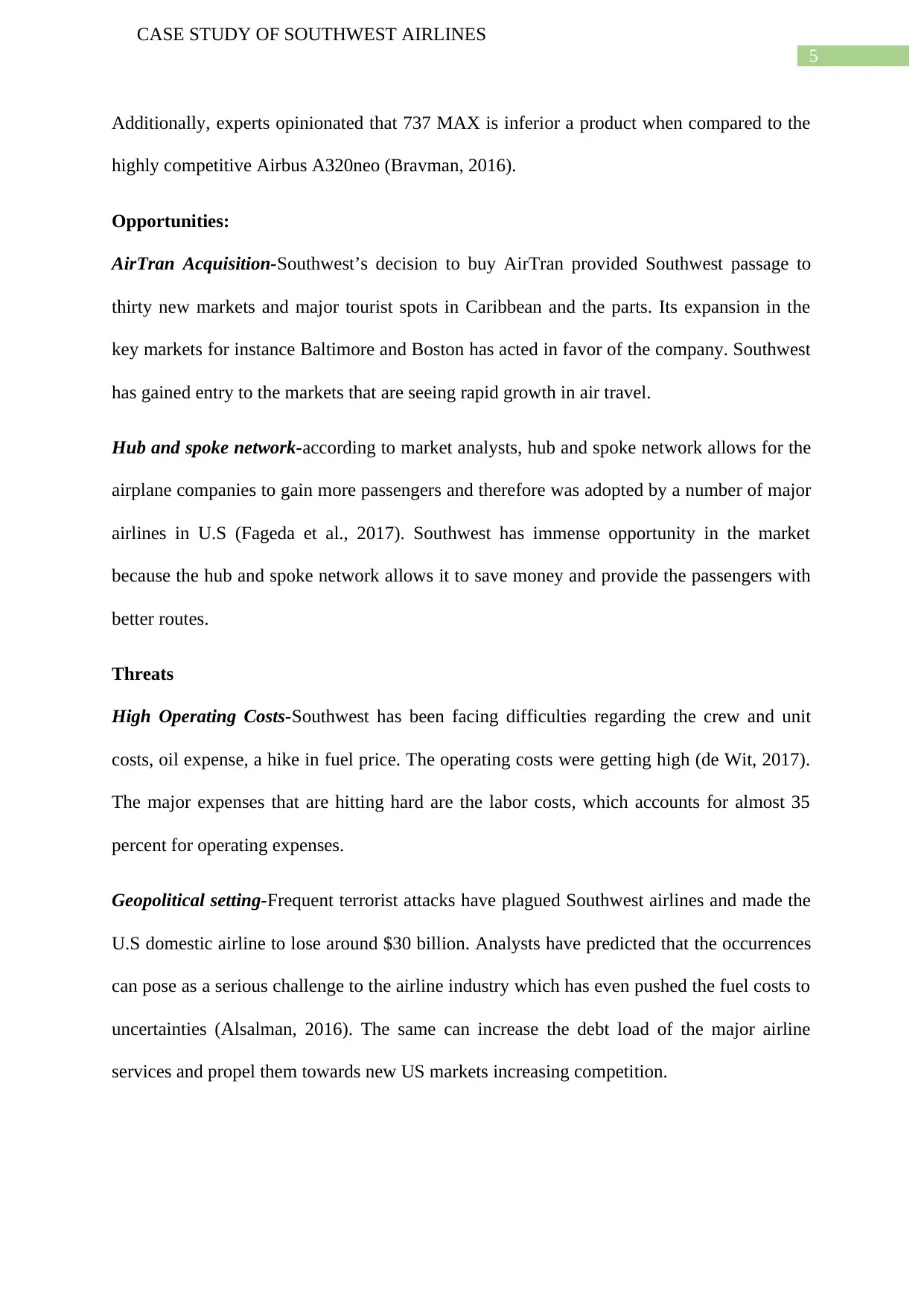
5
CASE STUDY OF SOUTHWEST AIRLINES
Additionally, experts opinionated that 737 MAX is inferior a product when compared to the
highly competitive Airbus A320neo (Bravman, 2016).
Opportunities:
AirTran Acquisition-Southwest’s decision to buy AirTran provided Southwest passage to
thirty new markets and major tourist spots in Caribbean and the parts. Its expansion in the
key markets for instance Baltimore and Boston has acted in favor of the company. Southwest
has gained entry to the markets that are seeing rapid growth in air travel.
Hub and spoke network-according to market analysts, hub and spoke network allows for the
airplane companies to gain more passengers and therefore was adopted by a number of major
airlines in U.S (Fageda et al., 2017). Southwest has immense opportunity in the market
because the hub and spoke network allows it to save money and provide the passengers with
better routes.
Threats
High Operating Costs-Southwest has been facing difficulties regarding the crew and unit
costs, oil expense, a hike in fuel price. The operating costs were getting high (de Wit, 2017).
The major expenses that are hitting hard are the labor costs, which accounts for almost 35
percent for operating expenses.
Geopolitical setting-Frequent terrorist attacks have plagued Southwest airlines and made the
U.S domestic airline to lose around $30 billion. Analysts have predicted that the occurrences
can pose as a serious challenge to the airline industry which has even pushed the fuel costs to
uncertainties (Alsalman, 2016). The same can increase the debt load of the major airline
services and propel them towards new US markets increasing competition.
CASE STUDY OF SOUTHWEST AIRLINES
Additionally, experts opinionated that 737 MAX is inferior a product when compared to the
highly competitive Airbus A320neo (Bravman, 2016).
Opportunities:
AirTran Acquisition-Southwest’s decision to buy AirTran provided Southwest passage to
thirty new markets and major tourist spots in Caribbean and the parts. Its expansion in the
key markets for instance Baltimore and Boston has acted in favor of the company. Southwest
has gained entry to the markets that are seeing rapid growth in air travel.
Hub and spoke network-according to market analysts, hub and spoke network allows for the
airplane companies to gain more passengers and therefore was adopted by a number of major
airlines in U.S (Fageda et al., 2017). Southwest has immense opportunity in the market
because the hub and spoke network allows it to save money and provide the passengers with
better routes.
Threats
High Operating Costs-Southwest has been facing difficulties regarding the crew and unit
costs, oil expense, a hike in fuel price. The operating costs were getting high (de Wit, 2017).
The major expenses that are hitting hard are the labor costs, which accounts for almost 35
percent for operating expenses.
Geopolitical setting-Frequent terrorist attacks have plagued Southwest airlines and made the
U.S domestic airline to lose around $30 billion. Analysts have predicted that the occurrences
can pose as a serious challenge to the airline industry which has even pushed the fuel costs to
uncertainties (Alsalman, 2016). The same can increase the debt load of the major airline
services and propel them towards new US markets increasing competition.
⊘ This is a preview!⊘
Do you want full access?
Subscribe today to unlock all pages.

Trusted by 1+ million students worldwide
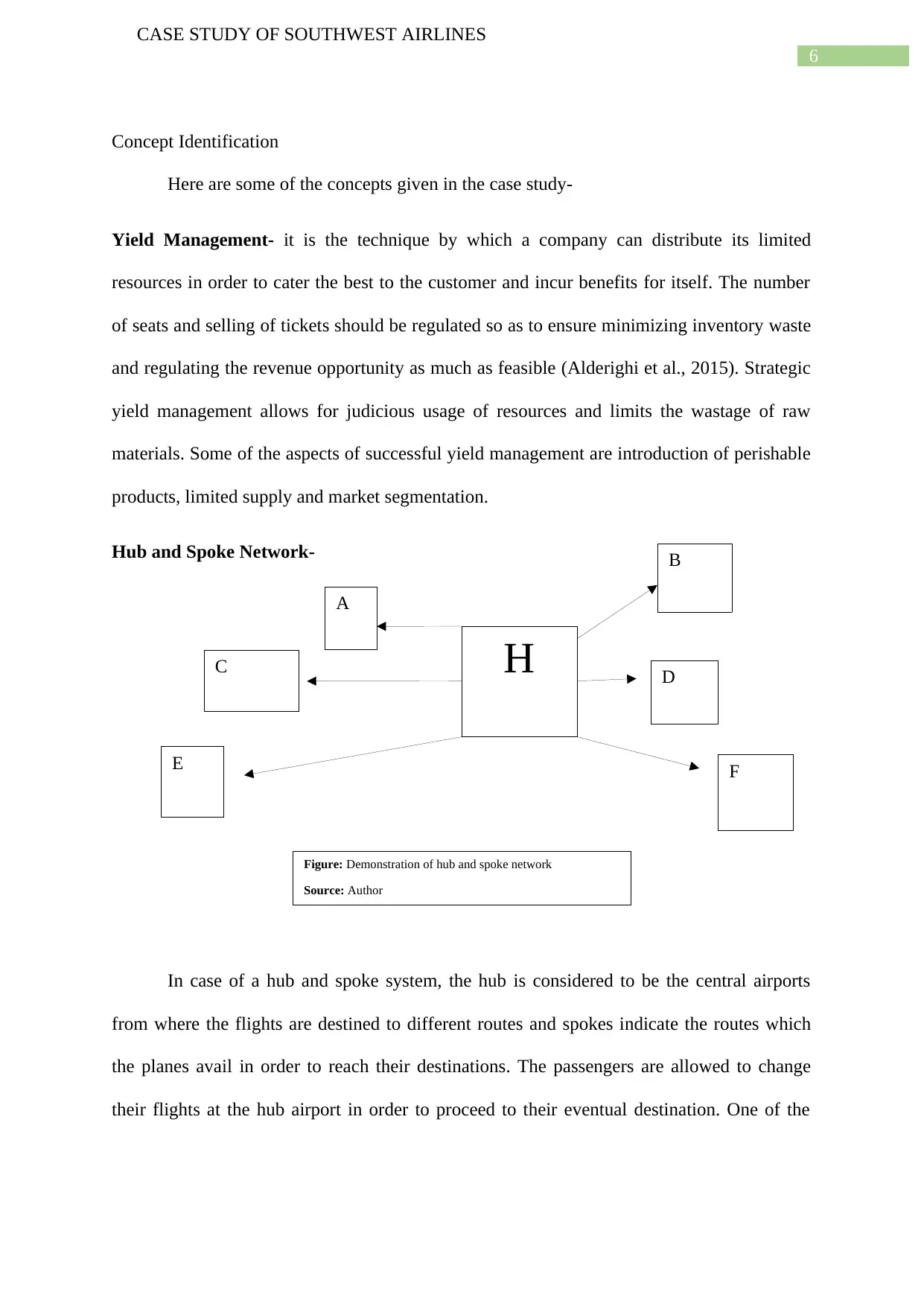
6
CASE STUDY OF SOUTHWEST AIRLINES
Concept Identification
Here are some of the concepts given in the case study-
Yield Management- it is the technique by which a company can distribute its limited
resources in order to cater the best to the customer and incur benefits for itself. The number
of seats and selling of tickets should be regulated so as to ensure minimizing inventory waste
and regulating the revenue opportunity as much as feasible (Alderighi et al., 2015). Strategic
yield management allows for judicious usage of resources and limits the wastage of raw
materials. Some of the aspects of successful yield management are introduction of perishable
products, limited supply and market segmentation.
Hub and Spoke Network-
In case of a hub and spoke system, the hub is considered to be the central airports
from where the flights are destined to different routes and spokes indicate the routes which
the planes avail in order to reach their destinations. The passengers are allowed to change
their flights at the hub airport in order to proceed to their eventual destination. One of the
H
A
C
E
B
D
F
Figure: Demonstration of hub and spoke network
Source: Author
CASE STUDY OF SOUTHWEST AIRLINES
Concept Identification
Here are some of the concepts given in the case study-
Yield Management- it is the technique by which a company can distribute its limited
resources in order to cater the best to the customer and incur benefits for itself. The number
of seats and selling of tickets should be regulated so as to ensure minimizing inventory waste
and regulating the revenue opportunity as much as feasible (Alderighi et al., 2015). Strategic
yield management allows for judicious usage of resources and limits the wastage of raw
materials. Some of the aspects of successful yield management are introduction of perishable
products, limited supply and market segmentation.
Hub and Spoke Network-
In case of a hub and spoke system, the hub is considered to be the central airports
from where the flights are destined to different routes and spokes indicate the routes which
the planes avail in order to reach their destinations. The passengers are allowed to change
their flights at the hub airport in order to proceed to their eventual destination. One of the
H
A
C
E
B
D
F
Figure: Demonstration of hub and spoke network
Source: Author
Paraphrase This Document
Need a fresh take? Get an instant paraphrase of this document with our AI Paraphraser
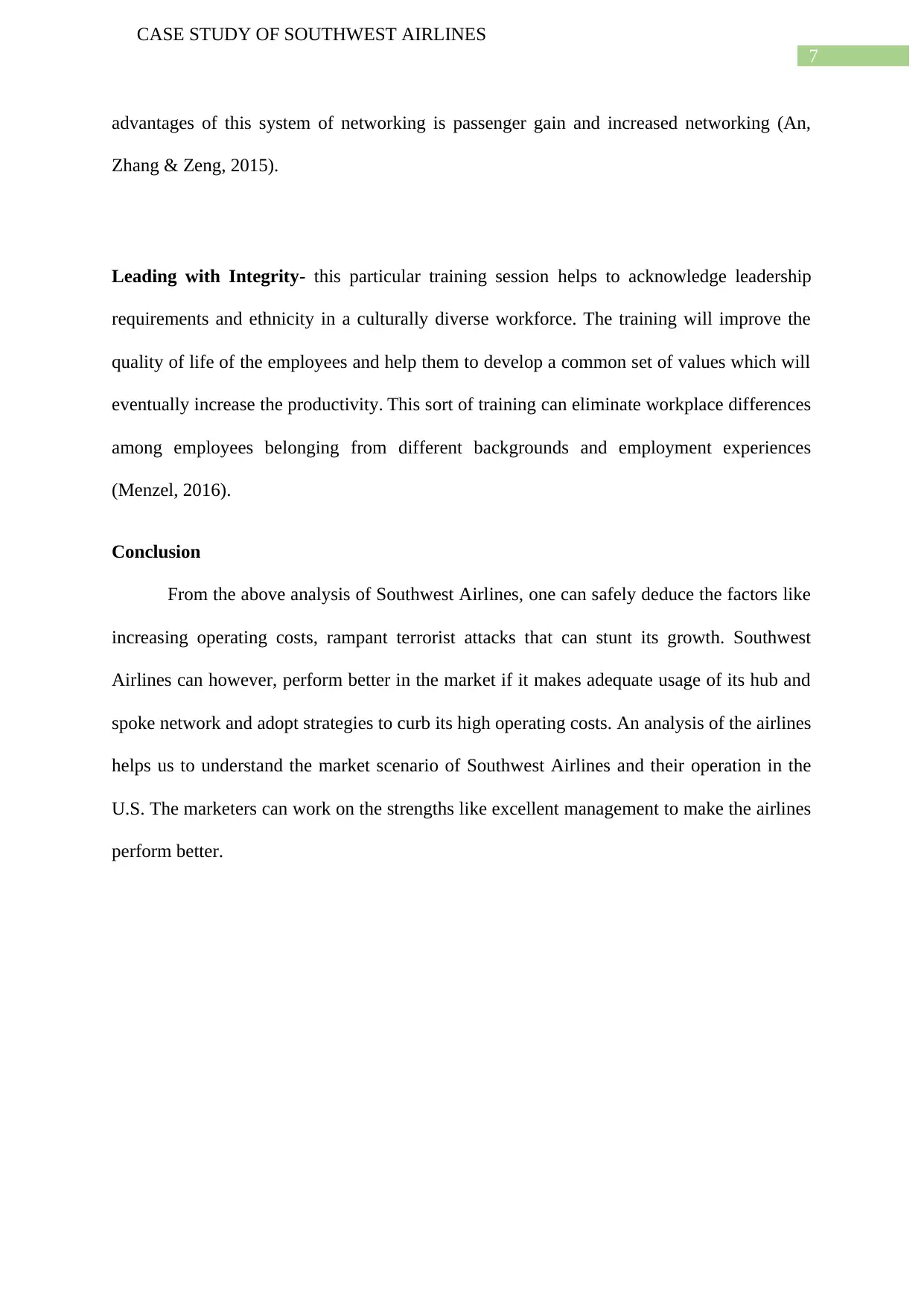
7
CASE STUDY OF SOUTHWEST AIRLINES
advantages of this system of networking is passenger gain and increased networking (An,
Zhang & Zeng, 2015).
Leading with Integrity- this particular training session helps to acknowledge leadership
requirements and ethnicity in a culturally diverse workforce. The training will improve the
quality of life of the employees and help them to develop a common set of values which will
eventually increase the productivity. This sort of training can eliminate workplace differences
among employees belonging from different backgrounds and employment experiences
(Menzel, 2016).
Conclusion
From the above analysis of Southwest Airlines, one can safely deduce the factors like
increasing operating costs, rampant terrorist attacks that can stunt its growth. Southwest
Airlines can however, perform better in the market if it makes adequate usage of its hub and
spoke network and adopt strategies to curb its high operating costs. An analysis of the airlines
helps us to understand the market scenario of Southwest Airlines and their operation in the
U.S. The marketers can work on the strengths like excellent management to make the airlines
perform better.
CASE STUDY OF SOUTHWEST AIRLINES
advantages of this system of networking is passenger gain and increased networking (An,
Zhang & Zeng, 2015).
Leading with Integrity- this particular training session helps to acknowledge leadership
requirements and ethnicity in a culturally diverse workforce. The training will improve the
quality of life of the employees and help them to develop a common set of values which will
eventually increase the productivity. This sort of training can eliminate workplace differences
among employees belonging from different backgrounds and employment experiences
(Menzel, 2016).
Conclusion
From the above analysis of Southwest Airlines, one can safely deduce the factors like
increasing operating costs, rampant terrorist attacks that can stunt its growth. Southwest
Airlines can however, perform better in the market if it makes adequate usage of its hub and
spoke network and adopt strategies to curb its high operating costs. An analysis of the airlines
helps us to understand the market scenario of Southwest Airlines and their operation in the
U.S. The marketers can work on the strengths like excellent management to make the airlines
perform better.
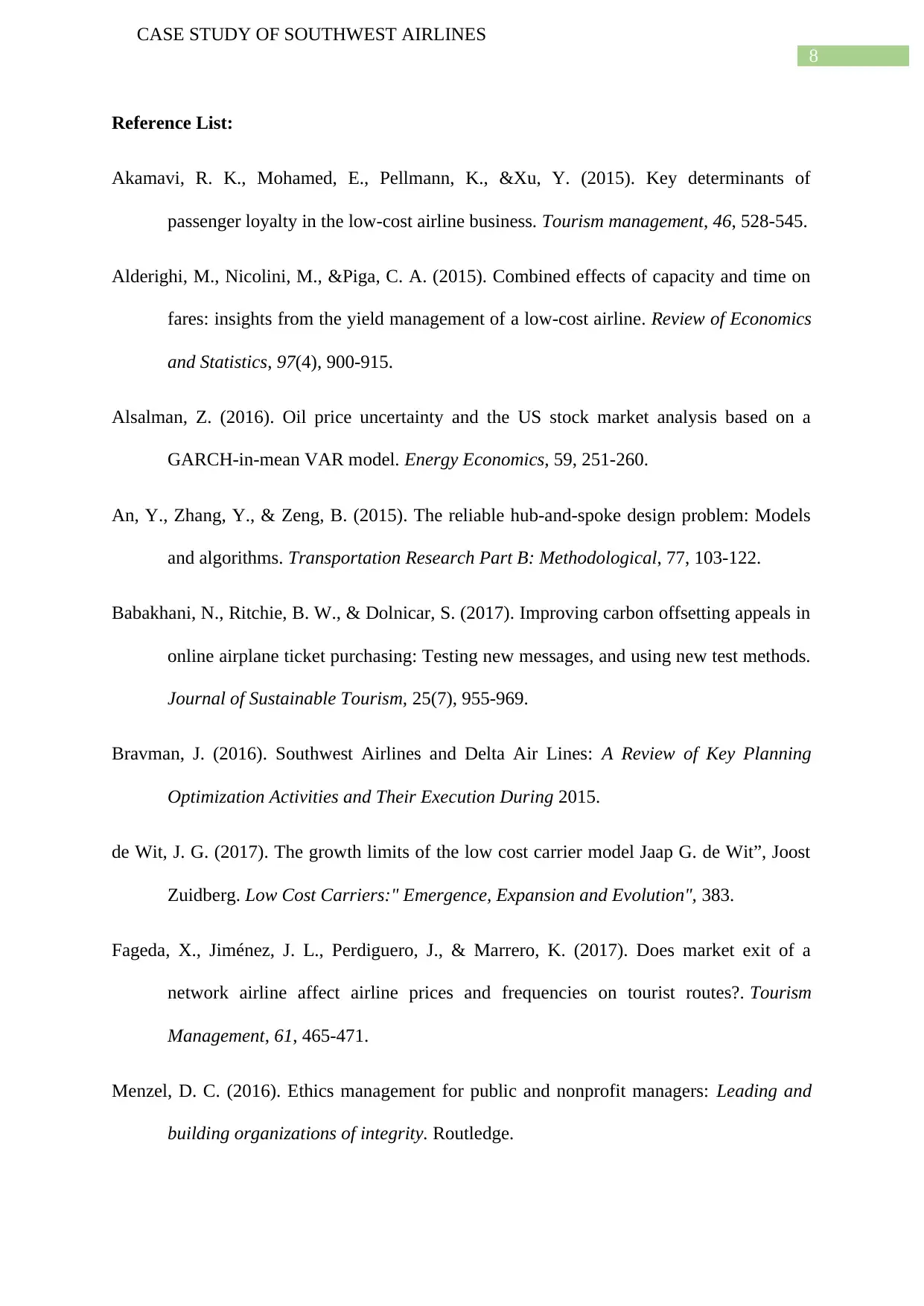
8
CASE STUDY OF SOUTHWEST AIRLINES
Reference List:
Akamavi, R. K., Mohamed, E., Pellmann, K., &Xu, Y. (2015). Key determinants of
passenger loyalty in the low-cost airline business. Tourism management, 46, 528-545.
Alderighi, M., Nicolini, M., &Piga, C. A. (2015). Combined effects of capacity and time on
fares: insights from the yield management of a low-cost airline. Review of Economics
and Statistics, 97(4), 900-915.
Alsalman, Z. (2016). Oil price uncertainty and the US stock market analysis based on a
GARCH-in-mean VAR model. Energy Economics, 59, 251-260.
An, Y., Zhang, Y., & Zeng, B. (2015). The reliable hub-and-spoke design problem: Models
and algorithms. Transportation Research Part B: Methodological, 77, 103-122.
Babakhani, N., Ritchie, B. W., & Dolnicar, S. (2017). Improving carbon offsetting appeals in
online airplane ticket purchasing: Testing new messages, and using new test methods.
Journal of Sustainable Tourism, 25(7), 955-969.
Bravman, J. (2016). Southwest Airlines and Delta Air Lines: A Review of Key Planning
Optimization Activities and Their Execution During 2015.
de Wit, J. G. (2017). The growth limits of the low cost carrier model Jaap G. de Wit”, Joost
Zuidberg. Low Cost Carriers:" Emergence, Expansion and Evolution", 383.
Fageda, X., Jiménez, J. L., Perdiguero, J., & Marrero, K. (2017). Does market exit of a
network airline affect airline prices and frequencies on tourist routes?. Tourism
Management, 61, 465-471.
Menzel, D. C. (2016). Ethics management for public and nonprofit managers: Leading and
building organizations of integrity. Routledge.
CASE STUDY OF SOUTHWEST AIRLINES
Reference List:
Akamavi, R. K., Mohamed, E., Pellmann, K., &Xu, Y. (2015). Key determinants of
passenger loyalty in the low-cost airline business. Tourism management, 46, 528-545.
Alderighi, M., Nicolini, M., &Piga, C. A. (2015). Combined effects of capacity and time on
fares: insights from the yield management of a low-cost airline. Review of Economics
and Statistics, 97(4), 900-915.
Alsalman, Z. (2016). Oil price uncertainty and the US stock market analysis based on a
GARCH-in-mean VAR model. Energy Economics, 59, 251-260.
An, Y., Zhang, Y., & Zeng, B. (2015). The reliable hub-and-spoke design problem: Models
and algorithms. Transportation Research Part B: Methodological, 77, 103-122.
Babakhani, N., Ritchie, B. W., & Dolnicar, S. (2017). Improving carbon offsetting appeals in
online airplane ticket purchasing: Testing new messages, and using new test methods.
Journal of Sustainable Tourism, 25(7), 955-969.
Bravman, J. (2016). Southwest Airlines and Delta Air Lines: A Review of Key Planning
Optimization Activities and Their Execution During 2015.
de Wit, J. G. (2017). The growth limits of the low cost carrier model Jaap G. de Wit”, Joost
Zuidberg. Low Cost Carriers:" Emergence, Expansion and Evolution", 383.
Fageda, X., Jiménez, J. L., Perdiguero, J., & Marrero, K. (2017). Does market exit of a
network airline affect airline prices and frequencies on tourist routes?. Tourism
Management, 61, 465-471.
Menzel, D. C. (2016). Ethics management for public and nonprofit managers: Leading and
building organizations of integrity. Routledge.
⊘ This is a preview!⊘
Do you want full access?
Subscribe today to unlock all pages.

Trusted by 1+ million students worldwide
1 out of 9
Related Documents
Your All-in-One AI-Powered Toolkit for Academic Success.
+13062052269
info@desklib.com
Available 24*7 on WhatsApp / Email
![[object Object]](/_next/static/media/star-bottom.7253800d.svg)
Unlock your academic potential
Copyright © 2020–2025 A2Z Services. All Rights Reserved. Developed and managed by ZUCOL.





